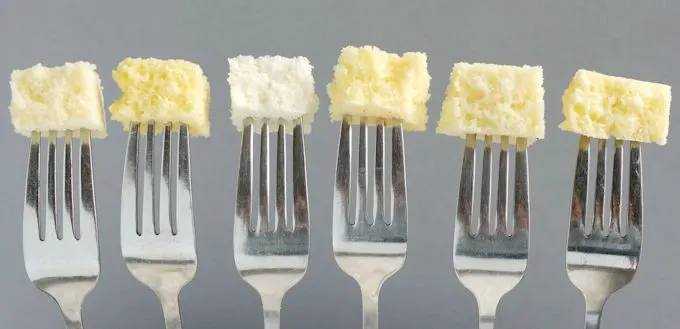The Function of Eggs in Cake
This is the fourth in a series of 7 “Cake Batter” classes. This article will explore an important ingredient in cake batter, eggs.

In the 3rd class we looked at one of the cake structure-builders, flour. We learned that low protein, chlorinated cake flour produced a cake with a light and tender texture. Now it’s time to learn about the other structure-builder for cake batter, eggs.
To learn detailed information about the composition and science of eggs as an ingredient, please visit the Baking Ingredients – Eggs page. This class will focus specifically on eggs in pound cake batter.
The Function of Eggs in Cake Batter:
The most important job of eggs in a cake batter is to contribute structure in the form of proteins from both the yolk and the white. The protein coagulates as the cake bakes and, along with the starch from the flour, forms the cake crumb.
So what does all this mean for our pound cake recipe? It means we can alter the cake significantly by manipulating the number of eggs, yolks and whites in the batter.
What Egg yolks do in cake batter
The yolk contributes protein, but also some fat, flavor, and emulsifying lecithin. Because emulsifiers hold water and fat together, adding extra egg yolks to the batter enables the batter to hold extra liquid and, consequently, extra sugar. This helps create a moister and sweeter cake that will still bake up with a good structure rather than falling into a gooey mass.
What Egg whites do in cake batter
When separated from the yolks and whipped to a foam, egg whites can be used to leaven a cake. Whipping egg whites has the same effect as cooking whites- the proteins unfold, reattach and trap water. Since the whipped whites are already partially “cooked” they don’t contribute as strongly to the structure of the cake.
In my testing I found that a cake made with the same proportion of yolks and whites had a softer texture when the whites were whipped and folded into the batter.
How to adjust the proportion of eggs in your cake recipe
- If you find your cake recipe tends to be on the dry side, try swapping out some of the egg whites for extra yolks.
- If you find your cake has a poor structure or is gummy, you can add some extra whites.
- To lighten a cake texture without adding more baking powder separate and whip the whites, then fold them into the batter.
Testing different amounts of eggs in cake batter:
I wanted to see how changing the number of yolks and whites in our pound cake recipe would affect the final product. So I baked six cakes, changing the number of yolks and whites for each test.
I kept the other ingredients (butter, sugar, flour) to 8 oz each. Though I varied the number of yolks and whites, I kept the total weight of eggs for each test at 8 oz.
For the last two tests I separated the eggs, whipped the whites with 2 oz of the sugar, and folded them into the batter before baking.
There is no “right” answer as to which outcome is the best. It’s a matter of taste and what works for your purposes. But knowing how to use eggs to tweak your recipes is a valuable tool for every baker.
You can learn how I used this information to create a great White Cake Recipe from my Vanilla Butter Cake Recipe.

Other cake batter classes:
Next up: Cake Batter Class #5 will explore the function of sugar in a pound cake recipe.
- About Reverse Creaming
- The function of salt and baking powder in cake batter
- The function of flour in cake batter
- The function of fat in cake batter
- The Cake recipe formula
When we’re done experimenting with all the ingredients for this “cake batter” course, we’ll use all we’ve learned to create Pound Cake Perfection.



I like fruit cake. I have some traditional recipes, but I always alter the ratios. Do you have a trustworthy recipe? Any classic ratio of fruits. Fruits to batter and such? Can I use your 4×4 cake recipe and then add the fruits? I’ve a half dozen more questions but I’ll stop there! Thanks loads! Darden
I have an aged fruitcake recipe that I’ve been using for 30 years. I love it. My recipe has about 2x the weight of fruit to cake. I also like this lighter “fruitcake” recipe made with Guinness.
Hi, I’ve been trying to make a lemon cupcake but i wanted to base it off a plain one so i can learn about the chemistry of cupcakes better, I’ve altered some of the ingredients already but i was wondering if i could add an extra egg yolk and then the lemon and if so, how much juice could i add?
An extra yolk would make the batter richer and it also helps emulsify the liquid in the batter. Generally, I like butter cakes with more yolks than whites for that reason. As far as lemon flavor, the zest of the lemon has the lemon oil, which gives more of the lemon flavor. So I would add finely grated lemon zest to the batter. You can also add a little lemon juice for acidity if you like. Replace some of the other liquid in your recipe with a tablespoon or so of the juice. It’s hard to be very specific without knowing your recipe, but I always use lemon zest and lemon extract for lemon flavoring.
Never mind. I read your ebook and I see the reasoning.
Great, enjoy!
Hi Eileen! Thank you so much for this information on eggs. Baking is truly a science. Yesterday, I visited a cupcake shop called SmallCakes. (not sure if you have one in your region.). Although, I did not like the frosting, the cake part was extremely fluffy and delicious. So, in order to get a fluffy cake do you add more whipped eggs to your batter? Or is it water and oil? I have been using your reverse mixing method which I love, but how do I get that added fluffiness? I really love the fluffiness.
Thanks Eileen for answering my questions!
I’m not familiar with SmallCakes so I can’t comment on their product. To change the texture of a cake you need to manipulate the ingredients. If you read through the “Cake Batter” classes under the “Baking School” tab (I know it’s a lot of info) you can see what each ingredient does for a cake. Generally, to get a lighter cake you need less flour, more eggs and maybe more liquid and baking powder.
Hi Eileen! Thank you for your suggestions. I read through the cake batter class information as you had mentioned. Then I altered the recipe using less flour, just a little more baking powder and just a 1/4 more of milk. I kept the egg amount the same because it was already plenty. The cake was so moist …and so fluffy! I had never baked a fluffy cake before, so I was thrilled. Thank you so much!
Hey, that’s great Kay. Nice work!!!
Hi. Thank you so much for sharing all your knowledge. I have to warn you, this might be a long comment. I’m REALLY hoping you can help me.
I really need some help! I have a yellow cake recipe. I absolutely love the flavor. It’s got a great vanilla and buttery flavor! But it stresses me out every time I have to make it. This recipe requires 2 egg whites to be whipped and folded in. I feel like I have to whip the whites for at least 10mins for it to foam up correctly, does that sound right?
Also, my cake ALWAYS sinks drastically. I like my final cakes to be 4″ tall. I always have to make this recipe 2 to 3 times just to get a good size height to make up for the sinking . (Oh and I’m familiar with folding in technique so I don’t think that’s the problem, but then again I feel like that IS the only problem… What else could it be?) Am I not whipping the whites enough?
Also, the cake seems to be so crumbley and extremely moist. Like, too moist. When I first made the cake I thought maybe it was undercooked, then I read on Cake Central that because the batter was consistent throughout it just means that it is a very moist cake. Like if u squeezed a piece of it, it would be like dough. From reading your post, I thought that maybe adding an extra egg white might help.
I know that was a lot of questions and someone on cake central suggested that I find a new recipe since this one gives me so much trouble. But I have tried so many recipes already and this one just tastes so great! Please help me. Thank you so much for any advice
Hi Amanda, it’s hard to know for sure without seeing the recipe, but it seems that the recipe has too much tenderizing ingredients and not enough structure building ingredients An extra egg white would be a good start. Read through this post about balancing a cake formula. Good luck!
@Amanda, easy fix. Bake your cake 2-3 min less than stated on your recipe. Instead of removing the cake from the oven. Wedge a wooden spoon between the door so your cake can cool a bit more gradually. Remove completely after about 20 mins.